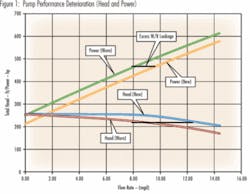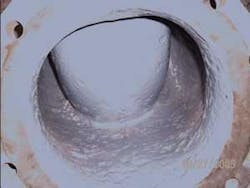Reconditioning Pumps To Improve Efficiency
by Allan R. Budris
With the ever increasing cost of energy these days, pump users are exploring every opportunity to reduce the energy consumption of their pumps, especially the high horse power units. Reconditioning pumps offers one such opportunity, and has been shown to have the potential to improve (regain) worn/corroded pump efficiencies by as much as 5 – 10% points or more. On the other hand, it may be difficult to justify such efficiency improvement efforts if the savings potential is not high enough and/or the performance gains cannot be capitalized on.
The following issues should be considered when investigating the potential for energy saving from pump reconditioning.
1) System requirements: If the pump performance has deteriorated to the point that it no longer satisfies the system flow and head requirements, then the pump must be reconditioned or replaced.
2) How much has the pump performance deteriorated? In order to establish the energy savings potential, a detailed pump / system analysis should be conducted, as spelled put in the writer’s January 2008 column, to determine the true performance degradation.
3) How much of the pump performance deterioration is caused by wearing ring clearance increase vs. the roughening of the pump waterways?
a. The amount of excess leakage flowing through worn wearing rings can be determined by comparing the “as new” (or factory) with the current (worn) power vs. flow curves (see Figure 1). As the clearance between pump wearing rings increases over time, the amount of flow that recirculates within the pump, from the discharge of the impeller to its suction, also increases. This increases the gross flow through the impeller, while reducing the net flow out of the pump. Since it is the impeller that consumes the power in a centrifugal pump, and pump input power normally increases with increased flow (except for high specific speed pump), pump input power will normally increase as the wearing ring clearance opens up. The power curve, therefore, shifts to the right by the amount of this excessive leakage. This is a good way of determining how much of the deterioration in pump efficiency is caused by the wear of this impeller to casing clearance.
b. This excessive recirculation through the worn wearing ring clearance also reduces the pump head (by shifting the H-Q curve to the left), by the amount of this increased leakage. This compounds its impact on pump efficiency, resulting in both increased power and reduced head. However, increased wearing ring clearance is not the only factor that reduces pump head. Any increase in the roughness of the casing (see figure 2) and impeller waterways, increases the friction caused pressure drop through the pump, which further reduces the net pump head. The head loss from a worn pump is, therefore, comprised of both effects, increased internal leakage flow and increased friction losses. That is why the shift of the head – capacity curve in figure 1 (4.4 mgd) is much greater than the shift of the power curve (1.6 mgd). In this case only about 1/3 of the H-Q curve shift (performance loss) is due to worn wearing rings.
c. It should be noted that the amount of performance loss from increased roughness in a pump is determined by several factors:
i. The magnitude of the roughness of the waterways.
ii. The specific speed of the pump. The higher the specific speed (higher the flow and lower the head) the greater the impact of the increased friction/roughness.
iii. The size of the water passages, compared to the roughness. Larger pumps can tolerate greater amounts of roughness, for the same loss in pump efficiency.
4. Should the pump be reconditioned? Once the user has determined the magnitude of pump performance degradation; the breakdown of the losses between excess internal leakage and increased friction; the energy saving potential; and the cost to accomplish this repair, the payback for reconditioning of the pump can be determined. It should be noted that, for systems where the required flow rate is governed by a control valve, and the worn pump still meets the system requirement, that any savings in energy losses, by reducing the roughness of the pump waterways, will be lost across a resulting turn down of the control valve. The only way to save energy under this condition would be to also trim the impeller, to maintain the current head while reducing the power input. On the other hand, for applications which use variable speed drives for control, or which can operate at the higher flow rates for a shorter period of time, the energy savings from reducing pump roughness should be realized. Polishing or cleaning of the outer shrouds of the impeller may not result in any increase in efficiency, since it will actually slightly reduce the head developed by the impeller (some of which comes from the outer shrouds), by about the same amount that it reduces the input power. Any energy savings from the reduction in input power from renewing the wearing ring clearance should always result in achievable energy savings.
5. Methods of reconditioning pumps:
a. Waterways: There are many aftermarket methods for reconditioning pump casings and/or impeller internal passages, including wire brushing, sand/grit blasting and coatings. The Monroe County Water Authority, in collaboration with the New York State Energy and Research Development Authority, is in the middle of a study focusing on measuring the performance and efficiency enhancement from sandblasting and then coating of the casing interior with epoxy ceramic coatings. The study group of centrifugal horizontal split case pumps had been in service for a minimum of 10 years (see figure 3). They are using several different brushable epoxy coatings (Belzona, Chemclad & Henkel Locktite) for this study. They found that in most cases, the interior coatings increased pump efficiency by 5 – 10% or greater, which represented a recovery of about 70% to 80% of the friction loss. With the power consumption of these pumps in the range of 20 to 1750 HP, for this 50 mgd public drinking water supplier, reconditioning these pumps should achieve a sizable energy savings.
b. Wear Ring Clearances: Replacing pump wearing rings is normally a relatively easy fix, which will not only improve the efficiency and head of a pump, but will also reduce the NPSH requirement, since less flow and turbulence will be going through the eye of the impeller. The lower the pump specific speed (the lower the flow and higher the head), the greater will be the impact of wearing ring clearance on pump performance. There are non-galling composite materials, such as DuPont’s Vespel CR-6100, that will allow the wearing ring clearances to be reduced below the manufacture’s specification, saving even more energy and further reducing NPSHR
About the Author:
Allan R. Budris, P.E., is an independent consulting engineer who specializes in training, failure analysis, troubleshooting, reliability, efficiency audits and litigation support on pumps and pumping systems. With offices in Washington, NJ, he can be contacted via e-mail at [email protected].



